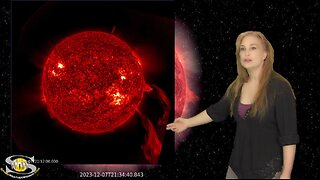Bright Regions Emerge Too Fast To Count | Space Weather News 09.22.2021
This Space Weather News forecast sponsored in part by Millersville University:
https://www.millersville.edu/swen
This week our Sun raises the bar with no less than six sunspots emerging in Earth view. These regions have been growing so fast that not all of them have been numbered yet (at the time of the forecast shoot). This means solar flux has shot up tremendously over the past few days and will continue climbing easily over this next week. We are rapidly moving through the 80s right now and could see triple digits again by next week. Amateur radio operators should notice much improved radio propagation on Earth's dayside in the coming days. In addition, we are also seeing an increase in big flare risk, which will also likely increase in the coming days. The main player is region 2871, but other regions may join the fray over the next few days. On top of this, we also have a coronal hole rotating into the Earth-strike zone, which will bring us some fast solar wind and the chance for aurora as we near the weekend. Aurora photographers at high and mid-latitudes should stay alert and keep their camera batteries charged this week as we also have an increased chance of Earth-directed solar storms with so many active regions now in play. Learn the details of the emerging new regions, find out when and where aurora might be visible, and see what else our Sun has in store this week!
Want early access to these forecasts, tutorials on Space Weather, & more? Visit:
https://patreon.com/SpaceweatherWoman
For daily and often hourly updates (during active times) visit me on Twitter:
https://twitter.com/TamithaSkov
For a more in-depth look at the data and images highlighted in this video see these links below.
Solar Imaging and Analysis:
SDO: http://sdo.gsfc.nasa.gov/data/
Helioviewer: http://www.helioviewer.org/
Flare Analysis: http://www.lmsal.com/solarsoft/latest_events/
Computer Aided CME Tracking CACTUS: http://www.sidc.oma.be/cactus/out/latestCMEs.html
GOES Xray: http://www.swpc.noaa.gov/rt_plots/xray_1m.html
SOHO: http://sohodata.nascom.nasa.gov/
Stereo: http://stereo.gsfc.nasa.gov/
GONG magnetic field synoptic movie: https://gong.nso.edu/data/magmap/standard_movie.html
GONG magnetic field synoptic charts: http://gong.nso.edu/data/magmap/
LMSAL Heliophysics Events HEK http://www.lmsal.com/isolsearch
Solar Wind:
DISCOVR solar wind: http://www.swpc.noaa.gov/products/real-time-solar-wind
ACE Solar Wind: http://www.swpc.noaa.gov/products/ace-real-time-solar-wind
NASA ENLIL SPIRAL: https://iswa.gsfc.nasa.gov/IswaSystemWebApp/iSWACygnetStreamer?timestamp=2038-01-23+00%3A44%3A00&window=-1&cygnetId=261
NOAA ENLIL SPIRAL: http://www.swpc.noaa.gov/products/wsa-enlil-solar-wind-prediction
Magnetosphere, Ionosphere, Atmosphere:
GOES Magnetometer: http://www.swpc.noaa.gov/products/goes-magnetometer
Ionosphere D-Region Absorption (DRAP) model: http://www.swpc.noaa.gov/products/d-region-absorption-predictions-d-rap/
Auroral Oval Ovation Products: http://www.swpc.noaa.gov/products/aurora-30-minute-forecast
Global 3-hr Kp index: http://www.swpc.noaa.gov/products/planetary-k-index
Wing Kp index prediction: http://www.swpc.noaa.gov/products/wing-kp
USGS Ground Magnetometers: http://geomag.usgs.gov/realtime/
USGS Disturbance Storm-Time (Dst): http://geomag.usgs.gov/realtime/dst/
NAIRAS Radiation Storm Model: http://sol.spacenvironment.net/raps_ops/current_files/globeView.html
Multi-Purpose Space Environment Sites:
NOAA/SWPC: http://www.swpc.noaa.gov
SOLARHAM: http://www.solarham.net/index.htm
Spaceweather: http://spaceweather.com
iSWA: http://iswa.gsfc.nasa.gov/iswa/iSWA.html
Definition of Geomagnetic Storm, Radiation Storm, and Radio Blackout Levels:
http://www.swpc.noaa.gov/NOAAscales/
None of this would be possible without the hard work and dedication of those who have provided all of this data for public use.
Images c/o NASA/ESA/CSA (most notably the superb SDO, SOHO, ACE, STEREO, CCMC, JPL & DSN teams, amazing professionals, hobbyists, institutions, organizations, agencies and amateurs such as those at the USAF/HAARP, NICT, NOAA, USGS, Environment Canada, Natural Resources Canada, Intellicast, Catatania, rice.edu, wisc.edu, sonoma.edu ucalgary.ca, rssi.ru, ohio-state.edu, solen.info, and more. Thanks for making Space Weather part of our every day dialogue.
-
 14:35
14:35
Dr. Tamitha Skov
6 months ago $0.02 earnedBig Flares, Mini-Storms & A Whole Lot of Eye Candy | Solar Storm Forecast 10 December 2023
2021 -
 5:00
5:00
ThinkStory
2 days agoHOUSE OF THE DRAGON Season 2 Episode 3 Preview Breakdown!
20.6K4 -
 13:45
13:45
Silver Dragons
1 day agoHUGE Silver News Dump - LIES ABOUT SILVER EXPOSED
14.6K7 -
 24:22
24:22
ThatStarWarsGirl
1 day agoI finally watched Disney Star Wars "The Acolyte"....
17.6K22 -
 13:03
13:03
NC Dirt Hunter
2 days agoCivil War Metal Detecting with the Xp Deus 2 metal detector.
19.6K4 -
 15:01
15:01
ScammerRevolts
1 day agoAngry Scammer Laughs After Getting His Files Deleted
13.1K11 -
 42:15
42:15
Andy Frisella
1 day agoThis Is The Price Of Reaching Your Goals - Ep 731 Q&AF
25.8K9 -
 14:52
14:52
Fascinating Horror
1 day agoThe Bazar de la Charité Fire | Fascinating Horror
43.9K6 -
 16:29
16:29
JoBlo Originals
23 hours agoWTF Happened to DAVID LETTERMAN?
31.8K17 -
 9:39
9:39
Degenerate Jay
1 day ago $0.02 earnedThese Classic Marvel Superhero Games Are Back! - The Marvel Vs Capcom Fighting Collection
44.8K8